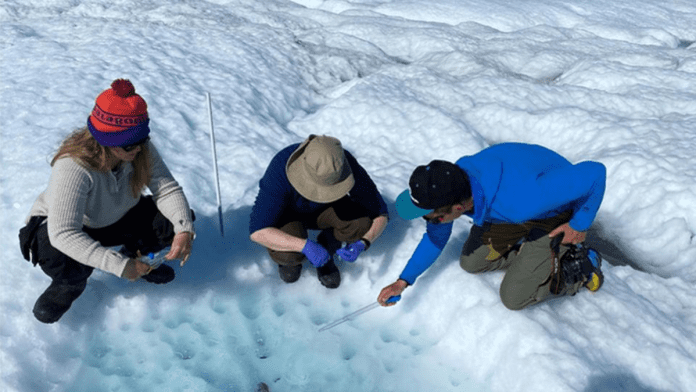🕒 Last updated on July 24, 2025
A team of researchers from Western Washington University has arrived on the icy edges of Greenland. They are spending 12 days studying one of Earth’s most important natural features—the Greenland Ice Sheet. The length of this enormous ice sheet is around 1,500 km. That’s about the distance from Bellingham, Washington, to Albuquerque, New Mexico.
A Research Adventure Begins in Greenland
The group is here to understand how the ice is melting faster than expected. What’s causing this rapid melting? It might be microscopic dark particles that are resting on the ice, such as dust, algae, and soot. These particles make the surface darker, which causes it to heat up and melt more quickly.
To aid with their investigation, the team brought a big drone. This drone, almost the size of a golden retriever, can fly over the ice and take special pictures. These images will show where the dark patches are and how they are affecting the ice.
How Dark Particles Speed Up Melting
You may have noticed that wearing a black shirt on a sunny day feels hotter. That’s because dark colors absorb sunlight while light colors reflect it. Ice, which is usually bright white, reflects most sunlight. However, the ice absorbs more heat and melts more quickly when it is covered in black particles.
Greenland’s ice is now covered in more of these dark materials than before. One big reason is wildfires. In 2023, Canada had a record wildfire season. Smoke from those fires traveled thousands of miles and landed on Greenland’s ice. That smoke carried black carbon and soot, which now sit on the icy surface.
The researchers want to know how much of this dark material made it to Greenland. They also want to understand what kind of particles are there—soot, dust, or algae—and how each one affects the melting.
Tools, Teamwork, and Safety in the Ice
To do this work, the team is using advanced tools and smart teamwork. One researcher is flying the drone to take detailed pictures of the ice. These images use special sensors to see what kind of light is being absorbed by the dark patches.
Another team member is walking across the ice to collect samples by hand. These samples will show what kind of particles are sitting on the surface and how many there are. This helps match what the drone sees from above with what’s really on the ground.
Foreign Powers Threatened as Greenland Cracks Down on Foreign Interference in Elections
They are also measuring how much sunlight reflects off the ice in each spot. This helps them learn how much heat the ice is soaking up. Less reflection means more melting.
But working in Greenland is not easy. The icy surface is full of dangers. One is the “moulin,” a deep hole that can go down thousands of feet. Falling in would be deadly. To stay safe, the team is guided by an expert local guide. This person also keeps watch for polar bears, which sometimes roam the area.
In the background, a video expert is capturing all these moments. These recordings will be used to tell the story of their important mission.
Ice Loss and Global Impact
Greenland lost 3.8 trillion tons of ice between 1992 and 2018. That is a tremendous sum. The fact that the ice is melting seven times more quickly than it did in the early 1990s is even more concerning.
Such melting is not just a problem for Greenland. Sea levels increase globally as a result of ice melting. Even a small rise—say one to six feet by the year 2100—could flood homes and towns. Around 150 million people live at or below three feet of elevation. This includes communities along coastlines like Puget Sound.
But the problem doesn’t stop with rising seas. The bright white ice sheets play another important role. By reflecting sunlight, they aid in cooling the planet. When they melt, darker land or water underneath is exposed. These darker surfaces absorb more heat, which can make the planet warmer.
Current climate models often miss one key detail—the dark particles. These particles are not yet included in many predictions. This implies that we might be underestimating the rate of ice melting and the potential severity of the consequences.
This is why the Greenland research is so crucial. The team’s work will help scientists understand the missing pieces and improve our knowledge of how the Earth is changing.

